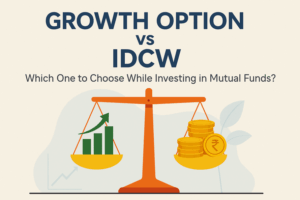SIP Calculator
×
Understanding the difference between SIP and mutual fund

The investment universe is deep and diverse. Investment products are available for all risk appetites ranging from fixed income securities to equity investments. Your investment portfolio can have diverse financial products to minimize risk and maximize returns.
Stock picking requires in-depth analysis, which can be tricky for newbie investors. The easy alternative is mutual funds, which are managed by professionals and do not require individual security picking. In fact, mutual fund investments are on the rise in India as retail investors seek a bite of India’s growth story. However, one question that baffles investors is ‘Is SIP and mutual fund the same?’
The simple explanation is that a mutual fund is a product and SIP (Systematic Investment Plan) is a way through which investors can invest in mutual funds. This blog post aims to simplify the SIP vs mutual fund debate. Let’s dig in.
What are mutual funds?
A mutual fund is an investment vehicle that pools money from multiple investors to invest in a diversified portfolio of securities such as stocks, bonds, or other assets.
Mutual funds, managed by professional fund managers, help investors achieve their financial goals without requiring extensive knowledge of the Indian debt or stock markets.
Key features of mutual funds
Understanding the key features of mutual funds will help you decode the SIP vs mutual fund debate better. Here are the key features of mutual fund investments:
- Diversification
Mutual funds spread investments across various sectors and asset classes, reducing the risk associated with concentration in a single industry or financial product.
- Professional Management
Investment decisions are based on market research and analysis and are made by experienced professionals.
- Liquidity
Mutual fund schemes can be open-ended or close-ended. In an open-ended scheme, investors can redeem their units anytime to cash in their investments. In close-ended schemes, the units are listed on exchanges, enabling investors to sell their units on the exchange. This means almost all mutual fund investments are liquid in nature.
- Flexibility
Investors have the flexibility to choose funds based on the dominant asset class the fund invests in. The various types of funds are – equity (small-cap, mid-cap, large-cap, flexi-cap, etc), debt funds (liquid funds, gilt funds, money market funds, etc), hybrid funds, and index funds. The range of funds enables investors to choose funds that match their risk profile and financial goals.
- Tax Benefits
Some mutual funds such as Equity Linked Savings Schemes (ELSS) offer tax deductions, making them tax efficient and thus a preferred investment option.
“Start investing with confidence! Explore the best
mutual funds
and grow your wealth.”
Investment options in mutual funds
Here are the ways in which you can invest in mutual funds:
- Lump Sum Investment:
A one-time investment where a large amount is invested upfront.
- Systematic Investment Plan (SIP):
A staggered approach where smaller amounts are invested periodically.
Mutual funds are investment instruments or products. When people talk about SIP vs mutual fund, they generally refer to SIP vs lumpsum mutual fund investment. In a sense, SIP and mutual funds are the same. This is because an SIP will invest money in the mutual fund scheme of your choice at regular intervals.
SIP
SIP is a disciplined method of investing in mutual funds. It allows investors to contribute a fixed amount at regular intervals—weekly, monthly, or quarterly—in a selected mutual fund scheme.
SIPs are particularly popular among retail investors due to their simplicity and affordability. SIP automates investment, increasing investment consistency and discipline.
Key Features of SIP
Here are the key features of SIP. Understanding them will make the SIP vs mutual fund difference easy to understand for investors.
- Rupee cost averaging
By investing regularly, investors buy more units when prices are low and fewer units when prices are high, averaging out the cost over time.
- Power of compounding
Regular investments grow exponentially over time as returns generate additional returns.
- Discipline and consistency
SIPs encourage regular savings and prevent impulsive financial decisions. Besides, SIPs help automate investments, increasing consistency and discipline of investments.
- Flexibility
Investors can start with as little as ₹500 per month and they have the option to increase, pause, or stop their SIPs anytime.
- Eliminates the need to time the market
SIPs eliminate the need to time the market, making them ideal for beginners.
SIP vs Mutual Funds: Key differences between mutual funds and SIP
The fundamental difference lies in their nature—mutual funds are investment products, while SIP is a mode of investing in those products. Here is a detailed comparison:
| Feature | Mutual Fund | SIP |
| Definition | A pool of money invested in securities by an asset management company (AMC). | A method of investing systematically in mutual funds over time. |
| Investment Type | Can be lump-sum or systematic (via SIP). | Only systematic investments at regular intervals. |
| Risk Management | Depends on fund type (equity/debt/hybrid). | Mitigates risk through rupee cost averaging. |
| Discipline | Requires investor discipline for lump-sum investments. | Encourages disciplined investing automatically. |
| Flexibility | Offers lump-sum or periodic investments; redemption depends on fund type. | Allows pausing or stopping contributions anytime without penalties. |
| Target Audience | Suitable for investors with varying risk appetites and investment knowledge levels. | Ideal for first-time investors or those with limited funds to invest regularly. |
While SIP is a way of investing in mutual funds, we have detailed how SIPs differ from mutual funds.
Advantages of combining SIP with mutual funds
Mutual fund investments are a great way to grow your wealth over time. Lumpsum investments work for entrepreneurs who have uncertain cash inflows and thus cannot commit a fixed investment. SIPs are perfect for salaried investors with a fixed income and thus can commit a fixed investment amount per month. SIP investments can help investors grow wealth over time.
Here is how investing in mutual funds via SIP can prove to be beneficial for investors:
- Accessibility for Small Investors
With SIPs starting at ₹500 per month, even individuals with limited income can invest in mutual funds.
- Long-Term Wealth Creation
The combination of compounding and rupee cost averaging helps build substantial wealth over time.
- Reduced Emotional Biases
Regular investments through SIP reduce the likelihood of emotional decision-making in volatile markets.
- Goal-Oriented Investing
Investors can align their SIP contributions to achieve specific financial goals like retirement planning or buying a house.
When to choose lump-sum over SIP?
While SIPs are ideal for most investors, investors should not discount lumpsum investment. Lumpsum mutual fund investments can be beneficial in the following scenarios:
- When you have a large corpus of money, from a bonus or other investments maturing.
- Market is in a downturn and you want to buy the dip.
Types of mutual funds accessible via SIP
Investors can use SIPs to invest in almost all types of mutual funds. Here are the types of mutual funds accessible via SIPs:
- Equity Funds: Focused on stocks; suitable for long-term growth but with higher risk.
- Debt Funds: Invest in fixed-income securities; ideal for conservative investors seeking stable returns.
- Hybrid Funds: Combine equity and debt; provide balanced risk-reward profiles.
- Index Funds: Passive funds that track market indices; cost-effective with lower management fees.
Key considerations before investing
Investments are a way to make money work for you. Here are the key factors you should consider before choosing a mutual fund scheme. The SIP vs mutual fund debate will follow these considerations.
- Assess your financial goals and classify them as short-term and long-term. Align your fund choices based on your investment horizon.
- Understand your risk tolerance before selecting a mutual fund type.
- Check the fund’s historical performance and expense ratio.
- Use tools like SIP calculators to estimate potential returns over your desired investment horizon.
Conclusion
In summary, while mutual funds serve as versatile investment products offering diversification and professional management, SIP is a systematic approach to investing in these funds over time. Both complement each other beautifully—SIP brings discipline and affordability to mutual fund investments, making it accessible even for small investors.
Understanding this distinction will enable you to align your investment strategy with your financial goals. Whether you’re a seasoned investor or just starting out, combining the power of mutual funds with the simplicity of SIP can help you effortlessly create wealth in the long term.
Disclaimer
The stocks mentioned in this article are not recommendations. Please conduct your own research and due diligence before investing. Investment in securities market are subject to market risks, read all the related documents carefully before investing. Please read the Risk Disclosure documents carefully before investing in Equity Shares, Derivatives, Mutual fund, and/or other instruments traded on the Stock Exchanges. As investments are subject to market risks and price fluctuation risk, there is no assurance or guarantee that the investment objectives shall be achieved. Lemonn (Formerly known as NU Investors Technologies Pvt. Ltd) do not guarantee any assured returns on any investments. Past performance of securities/instruments is not indicative of their future performance.







